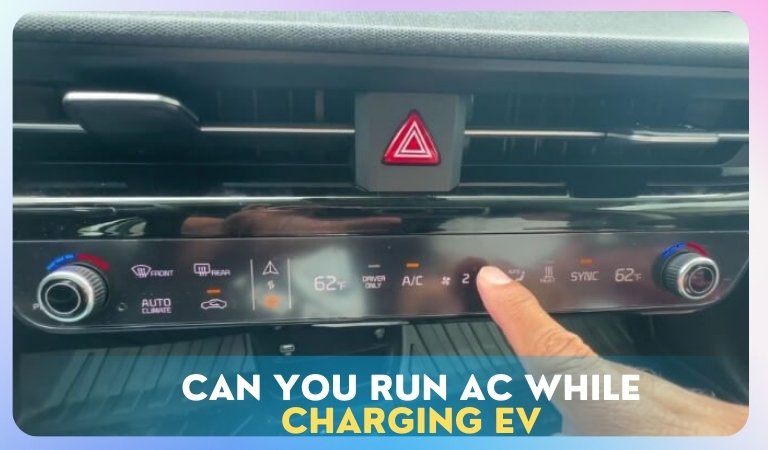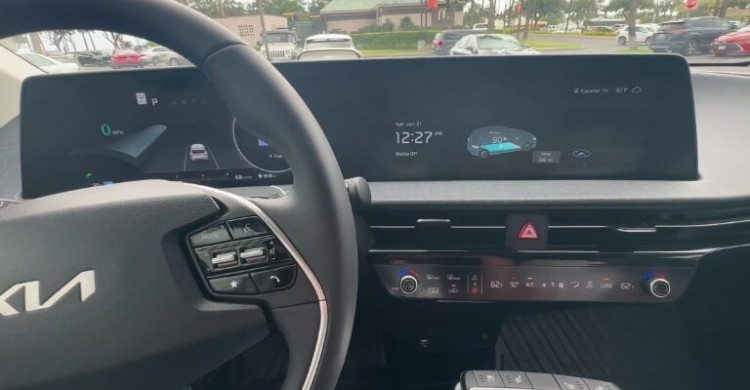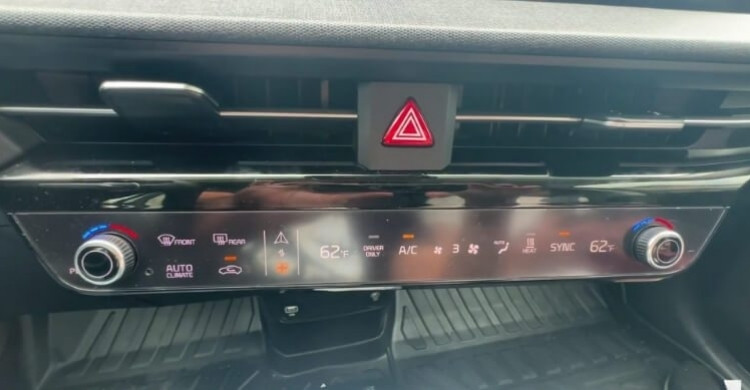Currently, electric vehicles (EVs) are becoming increasingly popular as a cleaner and more efficient mode of transportation. These advanced cars rely on battery power and require regular charging to keep you on the road. As more drivers make the switch, a practical concern often arises: Can you run AC while charging EV?
Yes, you can run AC while charging an EV. It’s generally safe, as modern EVs are designed for this. However, using the AC may slightly slow down the charging process because it draws some power from the battery while the vehicle is charging.
Throughout this article, we will examine how AC consumption impacts your EV’s charging and provide tips for optimizing your experience. So stay with us.
Can You Run AC While Charging EV?
Yes, you can run the AC while charging an EV. Electric vehicles are becoming more common, and people often wonder how they work during charging. One question that pops up a lot is about using AC while the car is charging. It might sound like a small thing, but it’s good to know how it affects your EV. Keep reading below to know what happens when running the AC while charging the EV:

Power Draw from Battery
When the AC is on, it uses electricity from the car’s battery. While charging, some of the incoming power goes to run the AC instead of fully charging the battery. This means the battery is getting less energy than if the AC were off. It’s a small change, but it can make charging take a bit longer, especially at public spots like EV charging stations in Bangladesh, where drivers may use the AC while waiting.
Slower Charging Speed
Because the AC uses some power, the battery charges more slowly. The charger still works, but the total time to reach full charge increases. How much slower depends on how strong the AC is and how fast the charger works. It’s not a huge delay, but it’s something to keep in mind if you’re in a hurry.
Battery Management System Adjusts
The car’s battery system watches and controls how much power goes where. When the AC is on, it makes sure the power is shared safely between charging and cooling. This helps keep your battery healthy and stops anything from overheating. The system does all this automatically, so you don’t have to worry.
Comfort Maintained
Even if charging slows a little, using the AC keeps you cool and comfortable. This can be really helpful on a hot day or while waiting in your car. You won’t have to choose between staying cool and charging the battery. Just remember, comfort may cost a few extra minutes on the charger.
Energy Efficiency Impact
Running the AC while charging does use more energy overall. It can make your EV slightly less efficient if you use AC a lot. That means a bit more power is used for cooling instead of storing it for driving. It’s not a big issue, but good to know if you’re watching your energy use.
What Functions Can Be Used During EV Charging?
Electric vehicles are smart and packed with useful features. When you plug in your EV to charge, your car doesn’t just sit there doing nothing. You can actually use some helpful functions while it charges. Want to know which ones? Here are the features that continue to function during EV charging:
Air Conditioning or Heater
You can turn on the AC or heater while the car is charging. Most EVs let you turn on EV while charging, so you can stay cool or warm without needing to unplug. This may slow charging just a bit, but it’s totally safe. It keeps you comfortable while the battery fills up.
Charging Status Display
While charging, the car shows how much power is going in. You can see how full the battery is and how much time is left. Some EVs even give you details like how fast it’s charging. This helps you plan your time better. It’s simple but really useful.
Cabin Lights and Screens
Need to find something inside the car at night? No problem — the lights inside still work. You can also turn on interior screens if you want. These don’t use much power and won’t affect charging much. It’s just like sitting in a parked car with the engine off.
Infotainment System
The screen in your car, music system, and apps can all work while charging. You can listen to music, watch videos, or check maps. Some EVs also let you browse the internet or play games. It’s a nice way to pass the time while waiting. You’re basically using the car like a mini entertainment center.
Phone Charging
Most EVs have USB ports or wireless charging pads. So while the car charges, you can charge your phone too. It’s handy if your phone is low and you’re waiting in the car. The phone uses only a small amount of power. It won’t mess with the car’s charging at all.
Climate Control Settings
Many EVs let you set the temperature before you even start driving. While charging, you can pre-cool or preheat the car. That way, it feels just right when you’re ready to go. This uses charging power but doesn’t hurt the battery. It’s a smart way to save time and energy.
How Much Power Does an AC Use During EV Charging?
When you run the AC while charging your EV, it uses extra power. The amount depends on how hot it is and how strong the AC runs. At first, the AC may use more power to cool the car down. Once the cabin is cooler, the power use drops to a lower level.

On average, the AC uses between 1 to 3 kilowatts of power. In very hot weather, it can go up to 6 kilowatts for a short time. This extra power comes from the charger, so charging may slow down a bit. But it’s still safe to use the AC while charging.
If your car is parked in the shade, the AC doesn’t have to work as hard. That means it uses less power and charging stays faster. Using a sunshade or parking under a tree can help keep the car cooler. This way, you stay comfortable without using too much extra energy.
Does Level 1 vs Level 2 EV Charging Make a Difference for AC Use?
Using the AC while your EV charges depends on the charger type. Level 1 and Level 2 chargers supply power at different rates, which affects how much power is left for other functions like AC. Below is a table comparing how Level 1 and Level 2 charging impact AC use:
| Point | Level 1 Charging | Level 2 Charging |
| Charging Speed | Very slow; adds about 3–5 miles per hour | Much faster; adds 15–30 miles per hour |
| Power Supply | 120 volts, low power output | 240 volts, higher power output |
| AC Impact | AC may slow charging noticeably | AC has minimal effect on charging speed |
| Best for AC Use | Not ideal with AC running | More suitable for running the AC during charging |
| Home Use | Common in standard home outlets | Requires special installation at home |
| Energy Sharing | Limited power for both charging and AC | Enough power to handle both comfortably |
| Battery Heat Management | May take longer to cool or heat the cabin | Heats or cools the cabin more efficiently |
| Overnight Charging with AC | Less efficient if AC is on | Still charges well overnight with the AC running |
| Cost to Install | No extra cost; uses existing outlet | Higher cost; needs a professional setup |
| Convenience for Daily Use | Slower and less practical for frequent AC use | Better for daily use with AC during charging |
What Should You Consider Before Using AC During EV Charging?
You might consider using the AC when charging your electric car. It sounds simple, but there are a few things to know before you do it. Using AC while charging can affect the process in small ways. To understand it better, check out the points below and see what matters most.
Charging Speed
When the AC is running, it takes some power from the charger. This means the car might charge more slowly than usual. It’s not a huge delay, but it can add extra time if the battery is low. If you’re in a hurry, turning off the AC can help speed things up. Knowing this helps you plan your charging time better.
Power Source Load
Running AC and charging at the same time puts more load on your home’s power. If your home charging setup isn’t strong enough, it could trip breakers or cause other small issues. Most modern setups can handle it, but it’s good to be sure. Always check your charger and power capacity. A stable setup means a safer and smoother experience.
Battery Usage
While your EV is charging, using the AC means the battery works a bit harder. The car has to manage charging and cooling together. This doesn’t damage the battery, but it can use a bit more energy overall. The car’s system balances this well, but it’s good to know what’s happening. It just means slightly more power is used during charging.
Charging Location
Where you’re charging makes a difference. If you’re charging at home, you usually have more time and comfort. But at a public charging spot, you might want to charge faster and leave. In that case, turning off the AC and finding a charging spot that partners with reliable service providers like Crack Platoon would be a better option. Always think about your location and how much time you’ve got.
Weather Conditions
Hot or cold weather can change how you use the AC. In summer, you’ll probably want the AC on while charging. But in cool weather, you might not need it at all. Using AC in extreme heat can use more energy and slow down charging. Knowing your weather helps you make a smart choice.
Comfort vs. Efficiency
Sometimes, staying comfortable is more important than saving a few minutes. If you’re tired or it’s really hot, using AC makes sense. But if you’re short on time, skipping it can help speed up charging. It’s all about what matters more to you at that moment. Think about whether you need comfort or quicker charging.
Tips to Improve EV Charging Efficiency When Using AC
Charging your EV while using the AC is totally doable, but it can affect how quickly your car charges. By making a few small adjustments, you can keep things efficient without giving up comfort. Here are some easy and useful tips to help you get the best out of your charging time.

- Pre-Cool the Cabin: Cool the car before plugging in to reduce the AC load during charging. This saves energy and makes charging more effective.
- Use Eco Mode Settings: Turn on your EV’s eco or energy-saving mode to limit power used by the AC. It helps balance comfort with charging speed.
- Charge During Cooler Hours: Charging early morning or late evening keeps AC use low due to cooler air. Less cooling means faster and more efficient charging.
- Limit Extra Device Use: Turn off seat warmers, infotainment, or lights when running AC during charging. These features add extra load and slow down charging.
- Keep Windows Closed: Open windows let hot air in, making the AC work harder. Closed windows reduce cooling time and help the battery charge better.
- Clean Air Filters Regularly: Dirty filters make the AC system work harder and use more power. A clean filter helps cool faster with less energy waste.
- Use Fan-Only When Possible: If it’s not too hot, switch to fan mode instead of full AC. This reduces energy use and supports charging speed.
- Monitor Charging With App: Use your EV app to track how AC affects charge time and battery levels. Real-time info helps you adjust your usage smartly.
Frequently Asked Questions
You’ve learned the basics of running the AC while charging your electric vehicle. But if you’re still curious or have a few doubts, you’re not alone. Below are some frequently asked questions that dig into the smaller details, giving you more clarity on this topic.
What Kind of EV Settings Help With AC Efficiency During Charging?
Some EVs include eco modes, scheduled climate settings, or limited fan speed options that save energy. These reduce the load on your AC system. Using these settings while charging can help the battery charge faster. It balances comfort without wasting too much energy.
Why Does My Charging Speed Drop When AC Is On?
The AC system pulls power from the same source as the charger. When both work together, your car divides energy between them. This slows charging slightly. It’s a small delay, but noticeable if you’re watching charging stats closely.
Which Conditions Make AC Less Efficient During Charging?
AC works harder in high heat, direct sunlight, or when windows are open. In these cases, more energy is required to keep the cabin cool. That means even more power is taken from the charger. Parking in the shade improves overall performance.
Can I Leave Pets in the Car While AC Runs Charging?
Yes, but always use caution. Many EVs offer pet or cabin safety modes that keep the AC running safely while the car is locked. Still, it’s important to check in often. Charging ensures the battery won’t run out during cooling.
Does My Charging Port Type Matter for AC Use?
No, the type of charging port (like CCS or CHAdeMO) doesn’t change how AC affects charging. What matters more is power output. Level 2 chargers offer more room for both AC and charging to work without slowing things down too much.
How Often Should I Run AC During Charging?
There’s no fixed rule, but use AC when you truly need it. Frequent use may add up in energy costs. If you’re charging often, small changes like pre-cooling or using low fan speed make a difference. Balance comfort with efficiency.
What Happens If AC Is Left Running After Charging Ends?
Most EVs turn off climate control after charging ends, unless scheduled otherwise. If AC keeps running, it draws power from the battery. This can slightly lower your range. It’s best to check your car’s app or settings for AC timers.
Bottom Line
As electric vehicles become a bigger part of our daily lives, understanding how to use them comfortably and efficiently is more important than ever. One question that comes up a lot is Can You Run AC While Charging EV? The good news is that yes, you can, and it’s generally safe to do so. It just might slow the charging process a bit.
Knowing how running the AC affects your EV helps you make smart choices about when and where to charge. Whether you’re at home or a public station, balancing comfort and charging speed is key. Simple steps like pre-cooling your car or charging during cooler hours can make a noticeable difference.
So next time you’re plugged in, don’t stress about staying cool. With a little awareness, you can enjoy a comfortable ride while keeping your EV charged and ready to go. Keep these tips in mind and make the most of every charging session.
